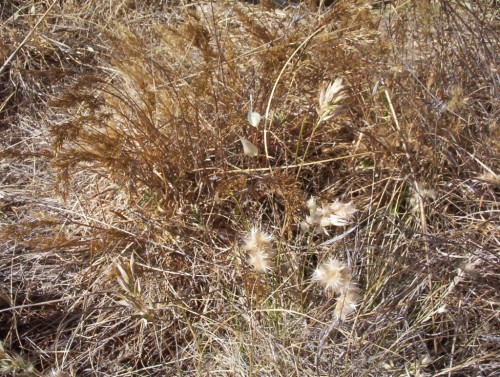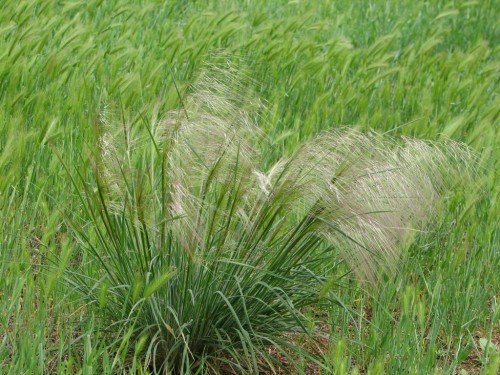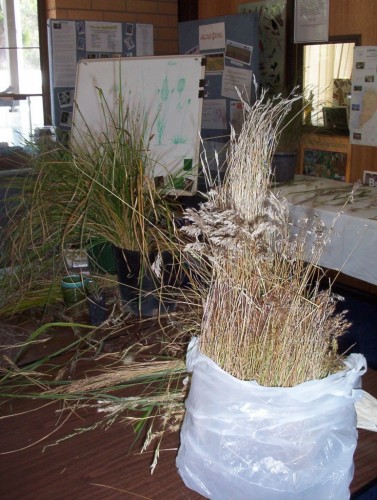Using Australian Native Grasses As Lawn
The suggestion was made that it would be worth trying Wallaby Grass (Austrodanthonia setacea) and Weeping Rice Grass (Microlaena stipoides) together in a lawn and that both would accept foot traffic. They would need to be watered probably every three weeks during late spring and summer to maintain a degree of greenness. I think it is worth the experiment to try this on a small scale to see if it is worth the effort of proceeding to a larger area. It means some propagation to get enough plants to have a quick cover of the area designated as ‘lawn’.
The photo shows a Wallaby Grass in the foreground. The cream heads are the seed heads of Austrodanthonia geniculata which is similar to the one I want to grow. The beauty of it is that I have it growing on our block and just need to find some fine leaved plants to use as propagating material.
The lawn would need to be mown when the plants flower to avoid seed set and the nuisance of picking seeds out of socks. This would be a matter of setting the mower at a high setting so that just the flower stalk is taken.
Grass Identification Field Day
We were in an area which was Department of Transport reserve land. To my eye there was quite lush growth compared to what I see growing on our place and similar areas in the district. The field day was in the Northern Lofty region which receives more rain than here where we live in a rain shadow.
It is amazing how, once you have been looking closely at grass plants, one’s eyes become quick to pick up the plants growing on the side of the road.
The photo shows some of the grassy woodland we were walking through with a large Eucalyptus viminalis (Manna Gum).
Austrostipa Species
I intend to master this book as I would like to be able to go further than say ‘that is an Austrostipa’.
I still have not found a suitable species to use as a native grass lawn. Our naturally low rain fall is the problem. There is no point in trying to establish something that uses as much water as some of the lawn grasses available. I have heard that there will possibly be a need to run a sprinkler once a month to keep the lawn looking like a lawn in the summer. That is a a problem in a particularly dry year as we are having. I guess the decision has to be made about whether we want to have a green patch or not. What would be the purpose of a native grass lawn?
More information on Australian Native Grasses may be found here.
New Grasses Book for South Australia
I still haven’t had a good look at it, or tried using the key for identification. That is something I want to try this week before all the Austrostipa (Spear Grass) seed drops. I hope I can get closer to an identification before I have to measure hairs on seed that might only be .3mm long!
The book contains the information from the 1986 Flora of South Australia by Jessop and Toelken, with corrections and updated information, including 61 extra species. Certainly a great resource for those interested in growing native grasses.
Grass Identification
I have been able to go to two sessions on grass identification at Mt Pleasant in the northern Mt Lofty Ranges. These were aimed at beginners and were as basic as deciding whether a plant was a grass or not, parts of grasses so that we could understand what is talked about in the Flora guides and deciding such seemingly simple things like the difference between a panicle and a raceme. It took me ages to ‘get it’.
Fortunately our tutors were able to speak layman’s language and make it all understandable and take us to the next stage of using the botanical terminology. In a few weeks we will have a field trip to help us recognise the plants rather than the pieces we were using indoors.
I always fear finding myself propagating introduced species of grasses. I am on a quest for a suitable grass to use as a lawn substitute that will not require excessive water to look good. I heard ‘lawn’ mentioned in one of the conversations, sat up to take notice of what was being said, only to have the other tutor say ‘oh, but…’ and sure enough what was being said applied to a higher rainfall area. Even though we are only 40 minutes drive away, we are in a definite rain shadow here.




